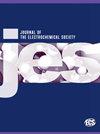在持续 pH 值梯度下进行低温水电解,电化学诱导石灰石脱碳成水合石灰
IF 3.3
4区 工程技术
Q2 ELECTROCHEMISTRY
引用次数: 0
摘要
石灰在各种环境应用中具有相当大的潜力。然而,目前石灰的生产仍然是高碳密集型的,每吨石灰排放的二氧化碳超过一吨。为了解决这个问题,最近的研究探索了石灰石脱碳电气化生产熟石灰的概念。在这项工作中,我们测试了一个能够在不同电流下生产 Ca(OH)2 的两室电解槽。精确的 pH 值和 Ca2+ 浓度测量结果表明,电解装置能够以接近完美的效率溶解 CaCO3 和沉淀 Ca(OH)2。值得注意的是,它强调了法拉第定律和传输数的概念可用于预测两个细胞隔室中每一步过程的平衡和动力学行为。此外,还评估了系统中 CaCO3 受控批量添加(而非一次性过量添加)的使用情况,以减轻用于分离隔室的阳离子交换膜的污垢。最后,根据实验结果,提出了实现每个步骤完美反应化学计量的关键准则。这些发现为采用更可持续、更环保的方法生产石灰铺平了道路。本文章由计算机程序翻译,如有差异,请以英文原文为准。
Low-Temperature Water Electrolysis Under a Sustained pH-Gradient for Electrochemically-Induced Decarbonation of Limestone into Hydrated Lime
Lime holds considerable potential in diverse environmental applications. However, its current production remains highly carbon-intensive, emitting more than one ton of CO2 per ton of lime. To address this issue, recent studies have explored the concept of electrifying the decarbonation of limestone to produce hydrated lime. In this work, a two-compartment electrolysis cell capable of producing Ca(OH)2 has been tested at different currents. Precise pH and Ca2+ concentration measurements demonstrate that the electrolysis setup is able to dissolve CaCO3 and precipitate Ca(OH)2 with near-perfect efficiencies. Notably, it highlights that Faraday’s law and the concept of transport number can be applied to predict both the equilibrium and kinetic behavior of each step of the process in each of the two cell compartments. Moreover, the use of controlled batch additions of CaCO3 in the system, as opposed to one-time excess addition, was assessed to mitigate the fouling of the cationic exchange membrane used to separate the compartments. Finally, based on the experimental findings, key guidelines are proposed to achieve a perfect reaction stoichiometry for each step. These findings pave the way for a more sustainable and environmentally friendly approach to lime production.
求助全文
通过发布文献求助,成功后即可免费获取论文全文。
去求助
来源期刊
CiteScore
7.20
自引率
12.80%
发文量
1369
审稿时长
1.5 months
期刊介绍:
The Journal of The Electrochemical Society (JES) is the leader in the field of solid-state and electrochemical science and technology. This peer-reviewed journal publishes an average of 450 pages of 70 articles each month. Articles are posted online, with a monthly paper edition following electronic publication. The ECS membership benefits package includes access to the electronic edition of this journal.

 求助内容:
求助内容: 应助结果提醒方式:
应助结果提醒方式:


